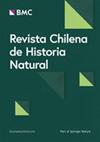智利火地岛大岛灰狐(Lycalopex griseus)的密度、丰度和活动情况
IF 1.4
4区 环境科学与生态学
Q3 BIODIVERSITY CONSERVATION
引用次数: 0
摘要
灰狐(Lycalopex griseus)是智利大陆和阿根廷邻近地区的原生物种。1951 年,它被引入火地岛大岛,并开始大量繁殖,这让当地的牧羊人十分懊恼。自 1998 年起,该物种被允许猎杀。在此,我们更新了火地岛智利地区狐狸的密度、丰度和活动情况,以评估自 2007 年农业和牧业服务局(SAG)进行上一次普查以来狐狸的数量变化趋势。2021 年和 2022 年 10 月至 11 月(春季),我们在公共道路上进行了两次狐狸普查,全长 941 公里,分为 8 条路线。我们的报告显示,与 2007 年的估计值相比,奇拉狐的密度和数量减少了 50%以上,这可能是由于自由放养的狗(Canis lupus familiaris)在传播疾病和寄生虫的同时限制了狐狸对空间的利用,以及人类的狩猎压力和车辆碰撞造成的干扰。奇拉狐的减少凸显了深入研究的必要性,以确定这一外来物种对火地岛生态系统的生态和社会经济影响,以及必要时对其进行管理的可取性。本文章由计算机程序翻译,如有差异,请以英文原文为准。
Density, abundance, and activity of the chilla or grey fox (Lycalopex griseus) in Isla Grande de Tierra del Fuego, Chile
The chilla or grey fox (Lycalopex griseus) is a native species from continental Chile and neighboring areas of Argentina. It was introduced to Isla Grande de Tierra del Fuego in 1951 and began to increase its abundance, to the chagrin of local sheep ranchers. Since 1998, its hunting has been authorized. Here we update information on the density, abundance, and activity of this fox in the Chilean sector of Tierra del Fuego Island, to evaluate its population trend since the last census conducted by the Servicio Agrícola y Ganadero (SAG) in 2007. We carried out two fox censuses on a 941-km transect on public roads, divided into eight routes, from October to November (spring) of 2021 and 2022, following the same design used by SAG for the fox assessments carried out from 1999 to 2007. We report a reduction of > 50% in the density and abundance of chilla foxes with respect to the 2007 estimate, which could be attributed to the interference by free-ranging dogs (Canis lupus familiaris), through restricting the use of space by the fox, while transmitting diseases and parasites, and to human hunting pressure and vehicle collisions. The chilla fox decline highlights the need for an in-depth study to determine the ecological and socioeconomic impact of this exotic species on the ecosystems of Tierra del Fuego Island and the desirability of its management, if needed.
求助全文
通过发布文献求助,成功后即可免费获取论文全文。
去求助
来源期刊

Revista Chilena de Historia Natural
环境科学-生态学
CiteScore
2.50
自引率
18.20%
发文量
9
审稿时长
>36 weeks
期刊介绍:
Revista Chilena de Historia Natural (RCHN) publishes original research dealing with past and present phenomena from organismic to higher levels of biological organization, considering both empirical and theoretical studies on all kinds of taxa and environments.
The major areas covered by RCHN are: botany and zoology; physiological and behavioral ecology; population biology; community and ecosystem ecology; systematics, biogeography and evolution.
 求助内容:
求助内容: 应助结果提醒方式:
应助结果提醒方式:


